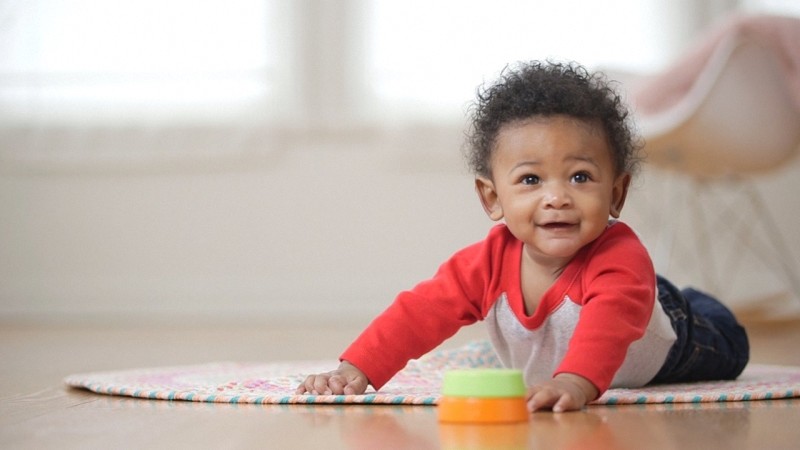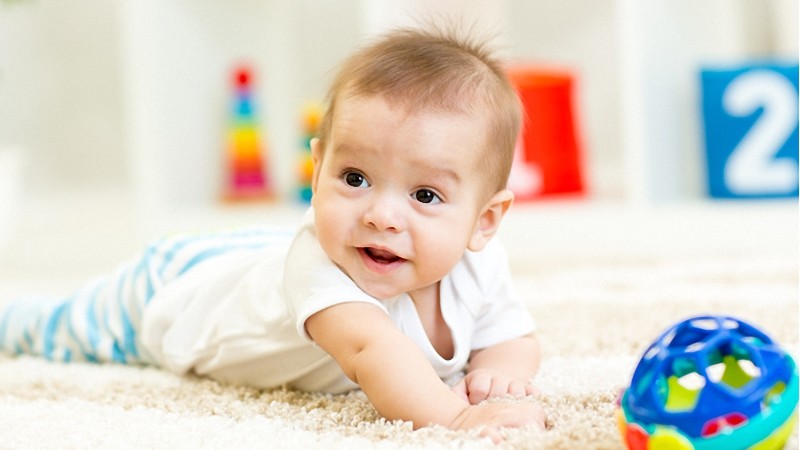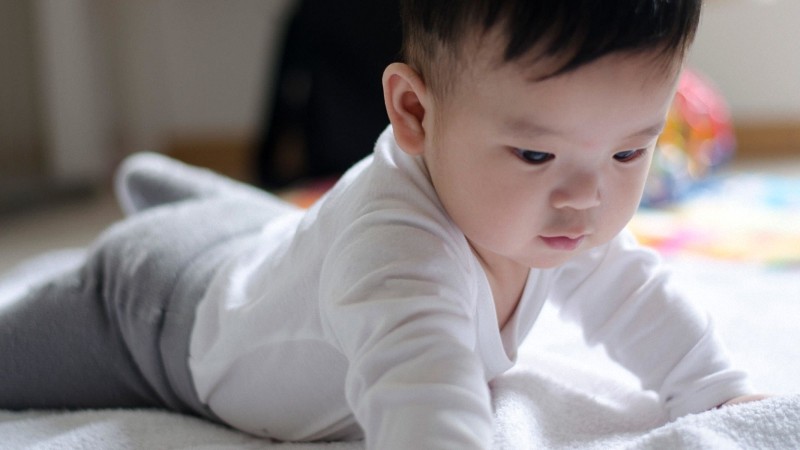Our children and their progress mean everything to us.
We carefully monitor and celebrate each milestone — every smile, every lifting of the head, and of course, every crawl.
That first crawl is something that every parent awaits like the biggest prize in the world. However, things aren’t as rosy as the enamored parents like to think they are, are they?
Crawling brings a whole new set of problems for new parents.
Suddenly, your baby can move, and even though crawling isn’t exactly speedy, you’ll find yourself wondering where your baby disappeared to more than once.
So, to prepare ourselves, we have to know when to expect this thrilling, sudden change.
Babies Start Crawling Around The 8-Month Mark
If you ask any developmental pediatrician when your baby is supposed to start crawling, the typical answer will be — around 8 or 9 months.
However, if you ask various parents when their children first crawled, you’ll see that the responses vary greatly.
There are developmental milestones that we, as parents, should pay attention to.
However, each baby is different, and two kids can start crawling at different times — even several months apart.
What Do the Experts Say?
Trusting various sources and other parents is a suitable way to figure out some parenting stuff.
However, let’s see what the research says.
The World Health Organization (WHO) conducted a study spanning over 5 different countries. With 800 children observed in the home environment, the scientist had the goal of determining the timetable of standard milestones. The observations took place once a month during the first year, and twice a month during the second year of life of all 800 babies.
The gathered data was about milestone behavior such as sitting and standing unsupported, standing while holding onto something, crawling, and walking without support.
The study gave pretty firm results that we can use as a reference when it comes to our kids.
Namely, around 51% of the 800 children that participated in the study started crawling by 8.5 months old. A month later, 75% of them were crawling, and two months later 90% of the children were crawling.
Therefore, it’s safe to say that our kids will start crawling sometime between the 8 and 10-month mark.
Of course, it’s entirely possible that your child develops the crawling ability as early as 5 months.
As mentioned before, each child has its own developmental path. So don’t start panicking if nothing happens by month 10. Some kids don’t start crawling until they are 12 months old. It’s rare, but it happens.

Why Is Crawling Such a Big Deal?
It’s crucial to note that crawling isn’t a prerequisite for walking. Most people think that a baby should first crawl for a while before developing that skill further into walking. However, that’s not always the case. Sometimes, kids skip the crawling stage entirely. That isn’t necessarily a bad thing.
Still, crawling has some benefits that the children who skip it might miss out on.
So, let’s skip to the nitty-gritty — why is crawling so important?
Crawling is the first milestone that includes coordinated bimanual movement in children.
Now, that’s a bunch of big words that some might not understand. What they essentially mean is that your baby is using both sides of its body and moving them in an alternating pattern.
Although the American Academy of Pediatrics states that crawling isn’t a prerequisite for walking, babies who crawl reap a multitude of perceptual and cognitive benefits from it.
Crawling includes coordination of multiple perceptive and cognitive functions. Moreover, it also enhances and develops them further.
Like any other function, crawling doesn’t happen independently. In fact, it’s a result of the cohesion of many abilities and functions that are all interconnected and interdependent.
For example, crawling is determined by, and enhances aspects like:
- Spatial capabilities
- Socioemotional processing
- Receptive, expressive language development
- Pattern connectivity in the brain
Therefore, don’t encourage your kids to walk straight away.
While it’s perfectly fine if their developmental path skips the crawling stage on its own, don’t encourage it and miss out on the benefits of crawling. Resist the urge to hold your kids’ hands and walk them around, or to provide something for them to prop themselves up and walk around, at least before they master the crawling stage.
Tips & Tricks on How to Help Your Baby Crawl
The first thing we should be mindful of is that we can’t magically speed up the developmental path of our child.
Some tips and tricks could help, but being patient and letting your child develop skills at their own pace is the best thing you can do.
Of course, we should encourage our kids, but it’s vital that we don’t over-do it.
Building Upper Body Strength
Our babies can’t start crawling before their bodies develop enough.
Crawling demands significant upper body strength. Until the baby has developed the necessary core and upper body strength, it won’t be able to crawl because its body won’t be able to resist the gravitational pull.
To help our babies develop the necessary strength, we can encourage tummy time. During tummy time, the baby will be able to practice pushing its upper body off the floor. Tummy time will allow the baby to explore its capabilities and strength.
If we don’t allow our kids to explore all their options, they’ll never know what they are capable of.
Model Behavior & Motivation
Kids learn by imitating the behavior of others. Whether it’s us who model a particular type of behavior or other kids, if we provide a stimulus, our kids will imitate it.
Show your kids how to crawl or bring them for a play date with other crawling children. It might seem silly for grown men and women to crawl around on the floor, but, let’s be honest — there’s little we wouldn’t do for our kids, right?
Providing a model that the baby can imitate is an excellent way for them to learn many skills, not just crawling. A model will motivate the baby to explore its capabilities. However, if that doesn’t work, or if we don’t have an appropriate model, we can always try to “bribe” our kids.
You know what they say — flattery and bribes will get you anywhere!
Inspiring Motivation to Crawl
If all else fails, we can always try to “trick” our baby into crawling. We suggest taking a favorite toy and placing it far away from the child. That way, you provide incentive and create enough space for the baby to move.
Space really is crucial here. If we don’t provide enough of it, then everything will be within baby’s reach. Therefore, it won’t have any need to crawl.
Patience Is of the Utmost Importance
It’s crucial that we be patient with our kids. As mentioned, each child has its own developmental path. That will become fairly clear to any parent after a short observation.
Crawling doesn’t happen overnight — it has some tell-tale signs that precede it.
In fact, most kids are relatively creative when it comes to movement. Don’t worry; if you look closely, you’ll know exactly when your child might start to crawl.
Babies will scoot, wiggle, roll and do all sorts of movements to move themselves across the floor before they start crawling. So if you see your baby creeping across the floor or scooting on its pretty little behind to get to something — crawling is just around the corner.

Commando, Bear, or a Real Creeper: Gross Motor Milestones
If you notice your babies crawling across the floor like a little commando soldier — by dragging the body with the use of their arms and elbows — then you’ll know that the crawling stage has begun.
Commando crawling usually occurs at 8 months.
A month later, babies “creep” across the floor. “Creeping” is a silly term we use to describe babies who push themselves on their stomachs. They often resemble little worms at this stage.
Furthermore, around the same time, we can also observe the “bear crawl” or a cartwheel crawl. This type of crawls resembles the real crawl the most. However, it differs in one feature — the baby’s legs aren’t bent at the knees.
The Final Stages of Crawling: Backward Crawling
After the different crawl stages, the baby will often get up on both hands and knees and start to rock back and forth.
That’s the final stage before the baby actually starts to crawl and it usually occurs at 9 months.
Aside from rocking, babies tend to try out their new skill backward first. Therefore, don’t be surprised if you see your little angel on all fours going away from you while facing you at the same time!
These gross motor milestones — commando crawling, creeping, and bear crawling — are typical and should be observed in each child’s behavior. If that’s not the case with your baby, we suggest consulting a medical professional.
But, is there also something you should do if your baby isn’t crawling? Also, why isn’t the baby crawling?
My Baby Isn’t Crawling — Should I be Worried?
As mentioned before, babies develop at different speeds. Yes, typically, your baby should crawl at 10 months. If it isn’t, there are a few possible reasons for that.
1. Differences in Developmental Path
Simply put — your baby might not be ready to crawl.
That is no real reason for concern if the baby is reaching other motor milestones. Your child might not be ready yet, but if the rest of the skills have been developing nicely, and the milestones have proven to be an easy feat for your child, then crawling is just around the corner.
2. Lack of Upper Body Strength
We already spoke about this — crawling demands a certain amount of core and upper body strength. If your child hasn’t developed their upper body yet, we suggest implementing tummy time every day.
3. Potential Developmental Disorders
Of course, if your baby isn’t crawling by the age of 10 months, there might be a more concerning reason for that.
Not reaching the crawling milestone can be a sign of a potential developmental disorder. That’s particularly true if your child has a particular way of moving around. If you’re concerned about the development of your child, you should always consult a pediatrician. Better safe than sorry!

Summing it All Up: When do Babies Crawl?
Every baby is different, and there are a few key milestones your baby needs to meet before they’re ready to crawl.
With that said, most babies will begin crawling around 8 months, sometimes a bit later — closer to the 10-month mark.
You shouldn’t be alarmed if you’re baby is slow to start crawling, they will start doing it when they’re ready. There are of course some things you can do to help your baby get started with each of the milestones. Namely, you can do things that help your baby begin building the body strength they need to start crawling and spend some time showing your baby what crawling looks like by doing some crawling yourself. Babies often mimic their parents as they develop.
As always, if you feel that you’re baby is developing much slower than normal, the best thing to do is visit your pediatrician so they can do their own tests to make sure your baby is progressing as expected.

